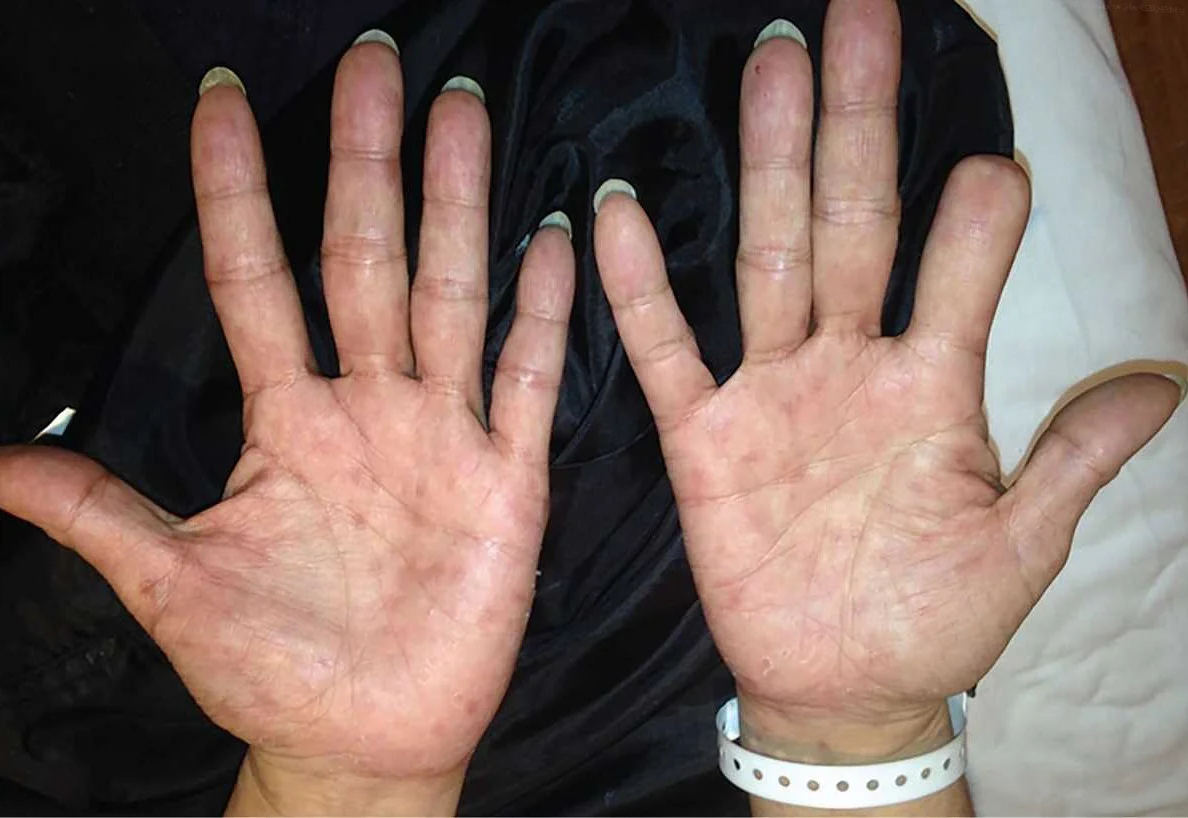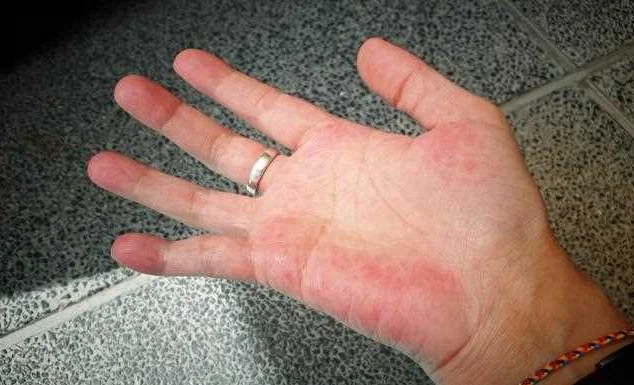2 Atypical Symptoms That Warn of Liver Problems
Содержимое
Discover two unusual symptoms that could indicate liver problems by examining your palms. Learn how to identify these signs and seek medical attention.
The liver is an essential organ in the human body, responsible for processing nutrients, detoxifying chemicals, and producing bile. When the liver is not functioning properly, it can lead to a variety of health issues. While most people are aware of the typical symptoms of liver problems, such as yellowing of the skin and eyes, there are lesser-known signs that can appear on the palms of the hands.
1. Palmer Erythema:
One of the atypical symptoms that can be seen on the palms is called palmer erythema. This condition is characterized by redness or a reddish-brown discoloration of the palms, which is often more prominent on the thenar and hypothenar eminences. It can be an early indicator of liver disease and may be accompanied by other symptoms such as fatigue, abdominal pain, and nausea. While palmer erythema can also be caused by other factors such as hormonal changes and certain medications, it is important to consult a healthcare professional for an accurate diagnosis.
2. Terry’s Nails:
Another warning sign of liver problems that can manifest on the palms is known as Terry’s nails. This condition is characterized by a white or pale band at the tip of the nail, with the rest of the nail appearing pink or brown. In some cases, the nails may also become thin, brittle, and have a spoon-shaped appearance. Terry’s nails can be associated with various health conditions, including liver disease. It is important to monitor any changes in the appearance of your nails and consult a healthcare professional if you notice any unusual signs.
If you notice any of these atypical symptoms on your palms, it is important not to ignore them. While they can be caused by factors other than liver problems, they can also be early warning signs of a more serious condition. Consulting a healthcare professional for a thorough evaluation and accurate diagnosis is crucial for timely intervention and appropriate treatment.
Disclaimer: This article is for informational purposes only and should not be considered medical advice. Always consult with a qualified healthcare professional for an accurate diagnosis and personalized treatment plan.
Yellowing Skin and Palms

One of the most noticeable symptoms of liver problems is yellowing of the skin and palms, a condition known as jaundice. Jaundice occurs when there is a buildup of bilirubin in the bloodstream, a yellow pigment that is produced by the liver when it breaks down old red blood cells. Normally, the liver filters out bilirubin and excretes it through the bile ducts. However, when the liver is damaged or not functioning properly, bilirubin can accumulate in the body, leading to yellowing of the skin and eyes.
In addition to yellowing of the skin and palms, other symptoms of jaundice may include dark urine, pale stools, fatigue, and abdominal pain. It is important to note that jaundice can be a sign of a serious underlying liver condition, such as hepatitis or cirrhosis. If you notice yellowing of your skin or palms, it is recommended to consult a healthcare professional for further evaluation and diagnosis.
Warning: Jaundice can also be a symptom of other medical conditions unrelated to the liver, such as hemolytic anemia or gallstones. Therefore, it is crucial to seek medical attention to determine the exact cause of your yellowing skin and palms.
Spider Angiomas on Palms

Spider angiomas, also known as spider nevi or spider veins, are a common skin condition characterized by a central red spot with blood vessels radiating outwards, resembling the legs of a spider. While spider angiomas commonly appear on the face and legs, they can also develop on the palms of the hands.
Spider angiomas on the palms may indicate an underlying liver problem. The liver plays a crucial role in filtering toxins from the blood, and when it is not functioning properly, it can cause blood vessels to dilate and become more visible. This can lead to the development of spider angiomas on the palms.
If you notice spider angiomas on your palms, it is important to consult with a healthcare professional. They can evaluate your symptoms, perform necessary tests, and determine if there is an underlying liver issue that needs to be addressed. Early detection and treatment of liver problems can help prevent further complications.
Other symptoms that may accompany spider angiomas on the palms include yellowing of the skin and eyes (jaundice), abdominal pain, fatigue, and unexplained weight loss. These are all potential signs of liver dysfunction and should not be ignored.
In conclusion, spider angiomas on the palms can be an atypical symptom of liver problems. If you notice these distinctive red spots on your hands, it is important to seek medical attention to ensure proper evaluation and treatment.
Abnormal Palm Redness
Abnormal palm redness is a distinct symptom that can indicate underlying liver problems. While it is normal for palms to appear slightly redder than the rest of the skin due to increased blood flow, persistent and abnormal redness may be a cause for concern.
One possible explanation for abnormal palm redness is liver disease. When the liver is not functioning properly, it can lead to a condition called hepatorenal syndrome, in which blood flow to the kidneys and other organs is affected. This can result in a buildup of toxins in the bloodstream, leading to redness and other abnormalities in the palms.
In addition to liver disease, abnormal palm redness can also be a sign of liver cancer. Liver cancer can cause an increase in blood vessels in the palms, leading to a reddened appearance. It is important to note that abnormal palm redness alone is not a definitive diagnosis of liver problems, but rather a potential symptom that should be evaluated by a healthcare professional.
If you notice persistent and abnormal redness in your palms, it is recommended to seek medical attention. A healthcare professional will be able to perform a thorough evaluation, including blood tests and imaging studies, to determine the underlying cause of the redness and develop an appropriate treatment plan.
Overall, abnormal palm redness can be a warning sign of liver problems and should not be ignored. Early detection and treatment of liver disease or liver cancer can significantly improve outcomes and quality of life.
Itchy Palms
Itchy palms can be a common symptom of liver problems. If you are experiencing persistent itching and irritation on your palms, it could be a sign that your liver is not functioning properly. The itching sensation may be accompanied by redness, swelling, and a rash.
Your liver is responsible for filtering toxins from your blood and producing bile, which helps break down fats. When your liver is not functioning properly, toxins can build up in your body, leading to symptoms like itchy palms.
If you have itchy palms, it is recommended to consult with a healthcare professional to determine the underlying cause. They may perform blood tests and other diagnostic procedures to assess your liver function and identify any potential liver problems.
In addition to liver problems, itchy palms can also be caused by other factors such as allergies, skin conditions, and certain medications. Therefore, it is important to seek medical advice to receive an accurate diagnosis and appropriate treatment.
Disclaimer: This article is for informational purposes only and does not constitute medical advice. It is always recommended to consult with a qualified healthcare professional for proper diagnosis and treatment.
Palmar Erythema

Palmar erythema is a condition characterized by the redness of the palms, specifically on the thenar and hypothenar eminences. This redness is caused by an increased number of small blood vessels near the surface of the skin.
While palmar erythema can occur in healthy individuals, it is often associated with liver problems. One of the main causes of this condition is liver disease, such as cirrhosis or hepatitis. The liver plays a vital role in the regulation of blood flow, so when it becomes impaired, the blood vessels in the palms can dilate, leading to the characteristic redness.
In addition to liver disease, palmar erythema can also be a sign of other underlying health issues, including hormonal imbalances, such as pregnancy or thyroid disorders, and autoimmune diseases, such as lupus.
If you notice persistent redness on your palms, especially if it is accompanied by other symptoms such as jaundice, abdominal pain, or fatigue, it is important to seek medical attention. A healthcare professional will be able to evaluate your symptoms, perform necessary tests, and determine the underlying cause of the palmar erythema.
While palmar erythema itself is not a dangerous condition, it serves as a warning sign that there may be an underlying health issue, particularly related to the liver. Early detection and treatment of liver problems can greatly improve outcomes and prevent further complications.
Swollen Palms

One of the atypical symptoms that may indicate liver problems is swelling in the palms of the hands. This can be caused by a condition called peripheral edema, which is the accumulation of fluid in the tissues. When the liver is not functioning properly, it can lead to fluid retention in the body, causing swelling in different parts, including the palms.
Swollen palms may be accompanied by other symptoms such as yellowing of the skin and eyes (jaundice), abdominal pain, fatigue, and loss of appetite. These symptoms can be a sign of liver damage or disease.
To determine if swollen palms are related to liver problems, a medical evaluation is necessary. The doctor may perform blood tests to check liver function and perform imaging tests to assess the liver’s condition. It is important to seek medical attention if you notice any unusual swelling or other symptoms, as early detection and treatment of liver problems can help prevent further damage and complications.
| Inflammation | Hepatitis |
| Fluid retention | Cirrhosis |
| Decreased liver function | Liver failure |
| Portal hypertension | Liver cancer |
If you are experiencing swollen palms along with other signs of liver problems, it is important to consult a healthcare professional for proper evaluation and diagnosis.